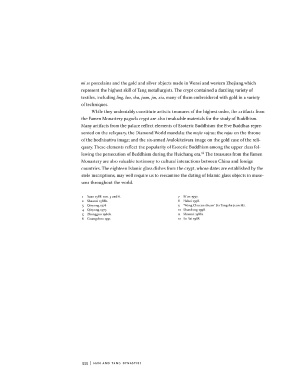Page 556 - The Golden Age of Chinese Archaeology: Celebrated Discoveries from the People’s Republic of China
P. 556
mi se porcelains and the gold and silver objects made in Wensi and western Zhejiang which
represent the highest skill of Tang metallurgists. The crypt contained a dazzling variety of
textiles, including ling, luo, sha, juan, jin, xiu, many of them embroidered with gold in a variety
of techniques.
While they undeniably constitute artistic treasures of the highest order, the artifacts from
the Famen Monastery pagoda crypt are also invaluable materials for the study of Buddhism.
Many artifacts from the palace reflect elements of Esoteric Buddhism: the Five Buddhas repre-
sented on the reliquary, the Diamond World mandala; the mojie vajras; the rajas on the throne
of the bodhisattva image; and the six-armed Avalokitesvara image on the gold case of the reli-
quary. These elements reflect the popularity of Esoteric Buddhism among the upper class fol-
12
lowing the persecution of Buddhism during the Huichang era. The treasures from the Famen
Monastery are also valuable testimony to cultural interactions between China and foreign
countries. The eighteen Islamic glass dishes from the crypt, whose dates are established by the
stele inscriptions, may well require us to reexamine the dating of Islamic glass objects in muse-
ums throughout the world.
1 Yuan 1988, nos. 5 and 6. 7 Xi'an 1997.
2 Shaanxi 1988)3. 8 Hebei 1998.
3 Qinyong 1978 9 "Wang Chucun zhuan" Jiu Tangshu juan 182.
4 Qinyong 1979. 10 Shandong 1998.
5 Zhongguo igSob. 11 Shaanxi 19883.
6 Guangzhou 1991. 12 Su Bai 1988.
555 | HAN AND TANG D Y N A S T I E S

